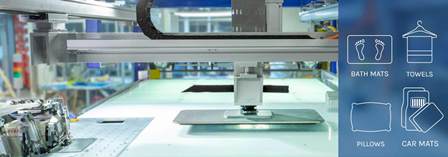 Since the beginning, SoftWear Automation has been working to make the Sewbot a platform for industrial sewing automation. While sewing is at the center of that challenge, the company has been successful because of its ability to master material handling such as picking, placing, moving, stacking, lifting, holding, labeling, welding and more. As it turns out, automated sewing may be the easiest part of sewing automation. What makes Lowry Sewbot special is the sheer number of products, operations and styles that one system can handle without an operator and without it being retooled, reprogrammed or re-configured.
Since the beginning, SoftWear Automation has been working to make the Sewbot a platform for industrial sewing automation. While sewing is at the center of that challenge, the company has been successful because of its ability to master material handling such as picking, placing, moving, stacking, lifting, holding, labeling, welding and more. As it turns out, automated sewing may be the easiest part of sewing automation. What makes Lowry Sewbot special is the sheer number of products, operations and styles that one system can handle without an operator and without it being retooled, reprogrammed or re-configured.
The major advancements in this next generation Sewbot have come from its improved vision technology, which has put it light years ahead in flexible production automation from previous releases. There is no question that textiles present challenges unique to industrial automation. Our needs as consumers to have textile products that are light, breathable, stretchable and fashionable create an ever changing landscape of complexity. Unlike hardware intensive solutions, vision technology allows Sewbot to adapt to handling the unique pieces of a material good.
The vision technology recognizes material shape, size, fabric, style and sewing requirements in order to calculate and complete full automation of a product. This means minimal retooling is required any time a change or an upgrade is made to the style or appearance of the product – reducing cost, downtime and labor. The machine vision also allows us to see material distortion in real time and to dynamically adjust to correct that distortion without any programming, resulting in high quality produced goods each and every time.
Lowry leverages all of the advancements the company has made in vision technology allowing for efficient production of sewn goods. Made of durable industrial-grade steel, the base frame has been upgraded to provide a machine that can run 24/7 and is able to withstand the test of time. Whether from potential damage from giant forklifts or wear and tear from micro particles, it is truly built to last on the factory floor. Lowry can also undertake simultaneous automated operations, such as automated loading, flaw detection, sewing, seaming, cutting, labeling and re-stacking all through a simple control touch panel. One single machine operator is able to control up to six Lowry systems at once, resulting in a significantly higher production scale.
Lowry enables companies to achieve on-demand production automation with its modular design and interchangeable components. SoftWear Automation understands that every sewn good is constructed differently, which is why Lowry has flexible configurations to support a variety of goods. Each machine module can be removed, replaced, upgraded, repurposed and repaired depending on the unique product specifications. For each product, Lowry has a product specific configuration available to enable full automation.
Lowry is built to serve a number of different industries, supporting both local and global supply chains and is available now, worldwide.
